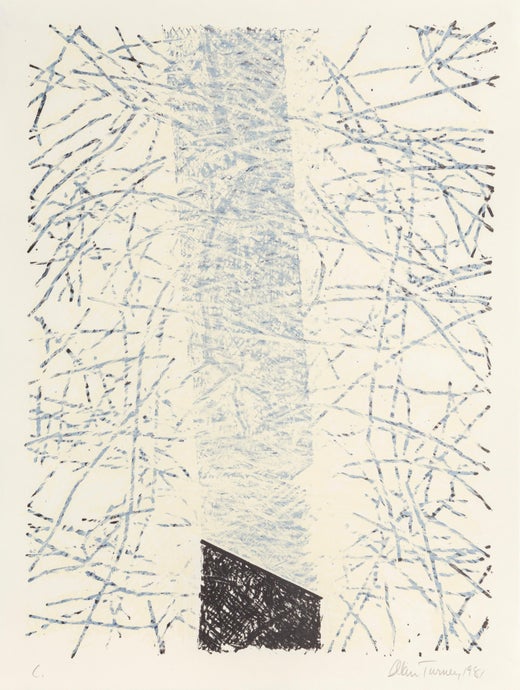1 of 5
Alan TurnerUntitled (Pink Tree)1983
1983
$2,700List Price
About the Item
- Creator:Alan Turner (1943 - 2020, American)
- Creation Year:1983
- Dimensions:Height: 23.5 in (59.69 cm)Width: 16.5 in (41.91 cm)Depth: 1 in (2.54 cm)
- More Editions & Sizes:Edition of 14Price: $2,700
- Medium:
- Period:
- Condition:
- Gallery Location:Winter Park, FL
- Reference Number:1stDibs: LU2776215017842
Alan Turner
Alan Lee Turner (1943 - 2020) was born in the Bronx, New York, on July 6, 1943. He earned a bachelor’s degree in art from City College in 1965, and a master’s degree from the University of California, Berkeley, two years later. While in California, Turner studied under David Hockney. “From David Hockney I learned to work from background to foreground in a painting,” he told Nadel in the 2017 interview. His work is included in the collections of the Museum of Modern Art and the Whitney Museum in New York, the Denver Art Museum, the Minneapolis Institute of Art, and the Museum of Fine Art, Boston, among other institutions and private collections.
Authenticity Guarantee
In the unlikely event there’s an issue with an item’s authenticity, contact us within 1 year for a full refund. DetailsMoney-Back Guarantee
If your item is not as described, is damaged in transit, or does not arrive, contact us within 7 days for a full refund. Details24-Hour Cancellation
You have a 24-hour grace period in which to reconsider your purchase, with no questions asked.Vetted Professional Sellers
Our world-class sellers must adhere to strict standards for service and quality, maintaining the integrity of our listings.Price-Match Guarantee
If you find that a seller listed the same item for a lower price elsewhere, we’ll match it.Trusted Global Delivery
Our best-in-class carrier network provides specialized shipping options worldwide, including custom delivery.You May Also Like
Nude - XXI Century, Contemporary Figurative Monotype Print, Blue & grey
By Siergiej Timochow
Located in Warsaw, PL
Siergiej Timochow, a Belorussian artist, born in 1960.
He studied at an art school in Minsk in 1979 before continuing to study at the Fine Arts Academy in Belarus.
His acrylic and ...
Category
Early 2000s Contemporary Figurative Prints
Materials
Cardboard, Monoprint, Monotype
$762
H 16.15 in W 22.05 in
Nude - XXI Century, Figurative Monotype Print, Monochromatic
By Siergiej Timochow
Located in Warsaw, PL
Siergiej Timochow, a Belorussian artist, born in 1960.
He studied at an art school in Minsk in 1979 before continuing to study at the Fine Arts Academy in Belarus.
His acrylic and ...
Category
Early 2000s Contemporary Figurative Prints
Materials
Cardboard, Monoprint
$821
H 20.87 in W 15.36 in
Union II
Located in Crested Butte, CO
When Many Becomes One is a series of new work exploring form and the relationship between the individual and collective. Paulo Wellman has employed vari...
Category
21st Century and Contemporary Abstract Geometric Abstract Prints
Materials
Monoprint
Wingcarrier-VI
Located in Crested Butte, CO
Collagraph with Monoprint technique. Each print is one-of-a-kind. This print also uses the Japanese technique Chine-Collee.
Category
2010s Contemporary Abstract Prints
Materials
Archival Ink, Color, Intaglio, Monoprint
Union I
Located in Crested Butte, CO
When Many Becomes One is a series of new work exploring form and the relationship between the individual and collective. Paulo Wellman has employed vari...
Category
21st Century and Contemporary Abstract Geometric Abstract Prints
Materials
Monoprint
Separation II
Located in Crested Butte, CO
When Many Becomes One is a series of new work exploring form and the relationship between the individual and collective. Paulo Wellman has employed vari...
Category
21st Century and Contemporary Abstract Geometric Abstract Prints
Materials
Monoprint
Wingcarrier-II
Located in Crested Butte, CO
Collagraph with Monoprint technique. Each print is one-of-a-kind.
Category
2010s Contemporary Abstract Prints
Materials
Ink, Archival Paper, Linocut, Monoprint
Mother
Located in Crested Butte, CO
When Many Becomes One is a series of new work exploring form and the relationship between the individual and collective. Paulo Wellman has employed vari...
Category
21st Century and Contemporary Abstract Geometric Abstract Prints
Materials
Monoprint
Wingcarrier-III
Located in Crested Butte, CO
Collagraph with Monoprint technique. Each print is one-of-a-kind. This print used the Japanese Chine-Collee technique additionally.
Category
2010s Contemporary Abstract Prints
Materials
Archival Ink, Intaglio, Monoprint
Separation I
Located in Crested Butte, CO
When Many Becomes One is a series of new work exploring form and the relationship between the individual and collective. Paulo Wellman has employed vari...
Category
21st Century and Contemporary Abstract Geometric Abstract Prints
Materials
Monoprint
Recently Viewed
View AllMore Ways To Browse
Takashi Murakami Superflat
Twa Vintage Print
Vintage Political Posters
Vintage Poster Washington
Winter Scene Prints
Agostino Tofanelli
Al Hirschfeld Etching
Alex Katz Woodcut
Altman Artist
Andy Warhol Exhibition Poster
Antique Farm Prints
Antonio Saura
Astronomy Print
Banksy Poster
Bonjour Vintage
Boulanger Lithograph
British Linocuts
By Mark Drew
